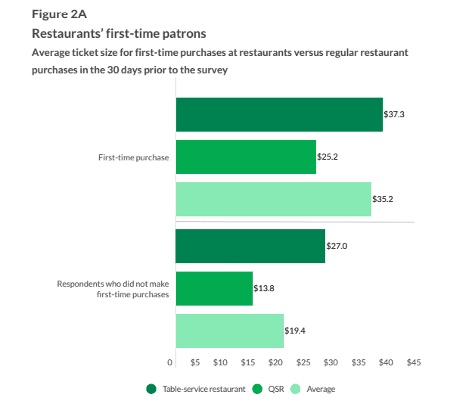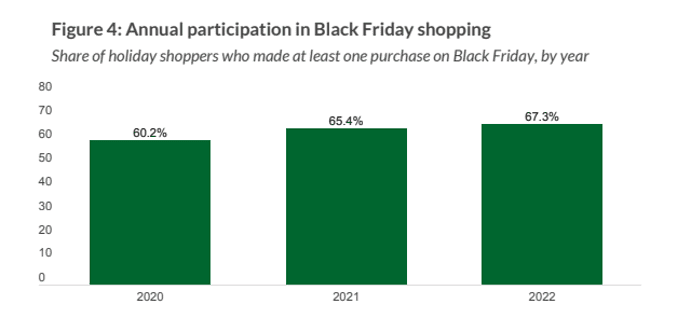Eat, Pay, Love — a Meditation on Holiday Spending

It turns out that dining, shopping, and even paying for such delights is uplifting. As in scientifically, and numerically as the case may be for top-line-minded businesses.
In homage to Elizabeth Gilbert’s inspiring story of one woman’s quest to follow her bliss, the PYMNTS Weekender “Eat, Pay, Love” edition tells the story of an emerging economic spin that follows our bliss — new data.
Using Gilbert’s own hierarchy as a loose outline, we begin with eating and loyalty. They pair like white wine and fish, as we found in “The 2022 Restaurant Digital Divide: Turning First-Time Diners Into Loyal Customers,” a survey of 2,256 hungry U.S. consumers.
Summarizing the value of loyal customers — which is to say guests who love your food and come back often — is proving to be a matter of converting first-time diners into loyalists.

“The average dining cost per person for new patrons at a table-service restaurant was $37 in late September and early October, $10 more than the overall average check at such locations. Consumers who eat out regularly paid even more — an average of $40 per person — when they went to a new restaurant in the 30 days prior to the survey.”
Gilbert had to go to Italy, India and Indonesia to discover the value of a great restaurant experience, but as we learn in every other book and/or film in the genre, love and loyalty are often right in front of you, or, in this case, at a nearby eatery (no long flights required).
See: The 2022 Restaurant Digital Divide: Turning First-Time Diners Into Loyal Customers
Pay it Forward
It’s taken many years, but Apple Pay, Google Pay and other digital wallets and cash equivalents are finally catching on with consumers. According to PYMNTS Black Friday research, aside from showing great patience till they find the right price, consumers are also showing a new affinity for real-time payments that don’t take on debt.
While still only a fraction of the credit and debit card payments juggernaut, these burgeoning ePayments delivered a seismic 60 to 100% increase in respective Apple Pay and Google Pay usage this year versus 2021, a payment shift that restaurants and pretty much every retail establishment should take note of and consider adding ASAP to their checkout menus.
At the time, the study “New Payment Options: Why Consumers Are Trying Digital Wallets,” a PYMNTS and Nuvei collaboration, asked 2,500 consumers about openness to trying new payment methods, and digital wallets were the clear winner.

As the study states, “Consumers demonstrated a willingness to give all manner of payment methods a first try in the past year, but digital wallets garnered the most usage. This was led by younger generations of consumers, with 66% of Gen Z consumers and 67% of millennials giving digital wallets trial runs.”
Get your copy: New Payment Options: Why Consumers Are Trying Digital Wallets
Love to Shop
So-called “retail therapy” may get a bad rap sometimes, but new science as well as record online shopping and spending over the first peak holiday weekend likely muted any derision in this area — at least for the time being.
And that is where we hit the “love” portion of this formula, as consumers proved once again that despite headwinds, layoffs, stretched budgets and more, they still love to shop for the holidays.
In fact, for some people, the act of shopping releases more dopamine than finishing a triathlon, dashing the idea that retail therapy isn’t therapeutic. Suffice to say, we know love when we see it.
And see it we did, during the recent Cyber Five weekend anchored by Black Friday. And yes, we studied that too. This is PYMNTS. As everyone knows, it’s kind of our thing.
While there are competing figures as to what was (or wasn’t) bought during the most anticipated shopping weekend of the year, we asked over 3,000 consumers about their experiences for the report “Black Friday 2022: High Prices Reshape Holiday Shopping Habits.”
Here’s the short version of a comprehensive study: 67% of holiday shoppers, representing 136.4 million individuals, made at least one holiday purchase on Black Friday 2022, marking a 3% gain over 2021 and giving a black (Friday) eye to all the depressing inflation news.

That’s our take on “eat, pay, love.” A seasonal swirl of connected economy evolution and old-fashioned business pragmatism, mixed with a dash of optimism, that things will get better, especially if I get this sweater.
See the study: Black Friday 2022: High Prices Reshape Holiday Shopping Habits
